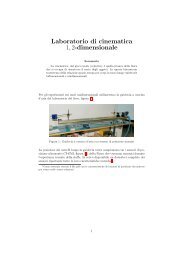Newton's law of cooling revisited - Cartan
Newton's law of cooling revisited - Cartan
Newton's law of cooling revisited - Cartan
You also want an ePaper? Increase the reach of your titles
YUMPU automatically turns print PDFs into web optimized ePapers that Google loves.
Newton’s <strong>law</strong> <strong>of</strong> <strong>cooling</strong> <strong>revisited</strong> 1065<br />
Biot number. Emphasis will be on objects with a small Biot number. Third, the assumptions<br />
underlying Newton’s <strong>law</strong> <strong>of</strong> <strong>cooling</strong> will be discussed. Fourth, the correct theoretical treatment<br />
<strong>of</strong> the radiative heat transfer leads to deviations from Newton’s <strong>law</strong> which will be discussed<br />
upon variation <strong>of</strong> a number <strong>of</strong> parameters. It will be demonstrated that the temperature range<br />
where Newton’s <strong>law</strong> is valid does sensitively depend on the relative contributions <strong>of</strong> convective<br />
versus radiative heat transfer. Finally, experimental results with temperature differences �T<br />
<strong>of</strong> up to 300 K will be presented which clearly verify the theoretically predicted deviations<br />
from Newton’s <strong>law</strong> <strong>of</strong> <strong>cooling</strong>.<br />
The problem as well as some experiments seem to be appropriate for undergraduate<br />
physics courses.<br />
2. The basic heat-transfer modes: conduction, convection and radiation<br />
Temperature differences in any situation result from energy flows into a system and energy<br />
flows from a system to the surrounding. The former leads to heating, whereas the latter<br />
results in <strong>cooling</strong> <strong>of</strong> an object. In thermodynamics, any kind <strong>of</strong> energy flow which is due to<br />
a temperature difference between a system and its surroundings is usually called heat flow<br />
or heat transfer. In physics, one usually distinguishes three kinds <strong>of</strong> heat flow: conduction,<br />
convection and radiation.<br />
2.1. Conduction<br />
Conduction refers to the heat flow in a solid or fluid (liquid or gas) which is at rest. Conduction<br />
<strong>of</strong> heat within an object, e.g. a one-dimensional wall, is usually assumed to be proportional<br />
to the temperature difference T1 − T2 on the two sides <strong>of</strong> the object as well as the surface<br />
area A <strong>of</strong> the object. This follows from the left-hand side <strong>of</strong> equation (1) by approximating<br />
dT/ds ≈ �T/s:<br />
˙QCond = λ · A · dT<br />
ds<br />
≈ λ<br />
s · A · (T1 − T2) = αCond · A · (T1 − T2). (1)<br />
The heat-transfer coefficient within the object is defined as αCond = λ<br />
, where λ is the<br />
s<br />
thermal conductivity and s is a measure for the object size. For the one-dimensional wall<br />
it would be the wall thickness. The heat-transfer coefficient αCond describes heat transfer in<br />
W(m2K) −1 . Hence the heat flux through the wall ˙QCond in W gives the energy flow per<br />
second through the wall <strong>of</strong> the surface area A if the temperature difference between the inner<br />
and outer surfaces is given. Typical values <strong>of</strong> heat-transfer coefficients for s = 10 cm ‘wall<br />
thickness’ for pure metals are <strong>of</strong> the order <strong>of</strong> 1000 W (m2 · K) −1 , building materials such as<br />
concrete, stones or glass range between 5 and 20 W (m2 · K) −1 , water has 0.6 W (m2 · K) −1 ,<br />
and insulating foams or gases range between 0.2 and 0.5 W (m2 · K) −1 .<br />
2.2. Convection<br />
In general, convection refers to the heat flow between a solid and a fluid in motion. The<br />
energy flow ˙QCond per second from the surface <strong>of</strong> an object with temperature T1 into a fluid<br />
<strong>of</strong> temperature T2 due to convection is usually assumed to follow a <strong>law</strong> similar to the one <strong>of</strong><br />
conduction<br />
˙QConv = αConv · A · (T1 − T2). (2)<br />
The heat-transfer coefficient for convection depends on the nature <strong>of</strong> the motion <strong>of</strong> the fluid,<br />
on the fluid velocity and on temperature differences. One distinguishes free convection where




